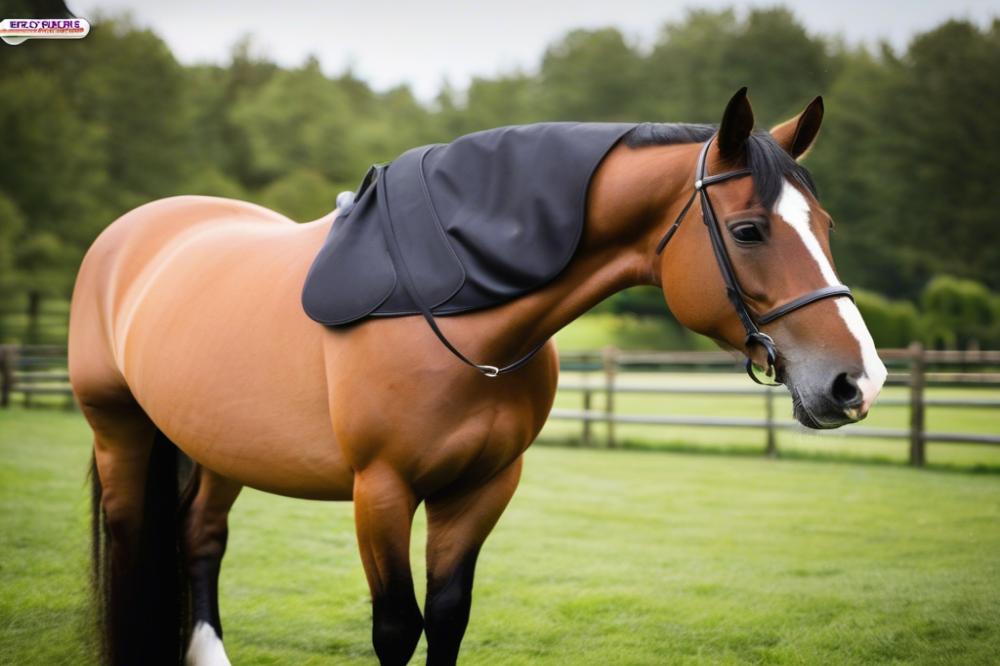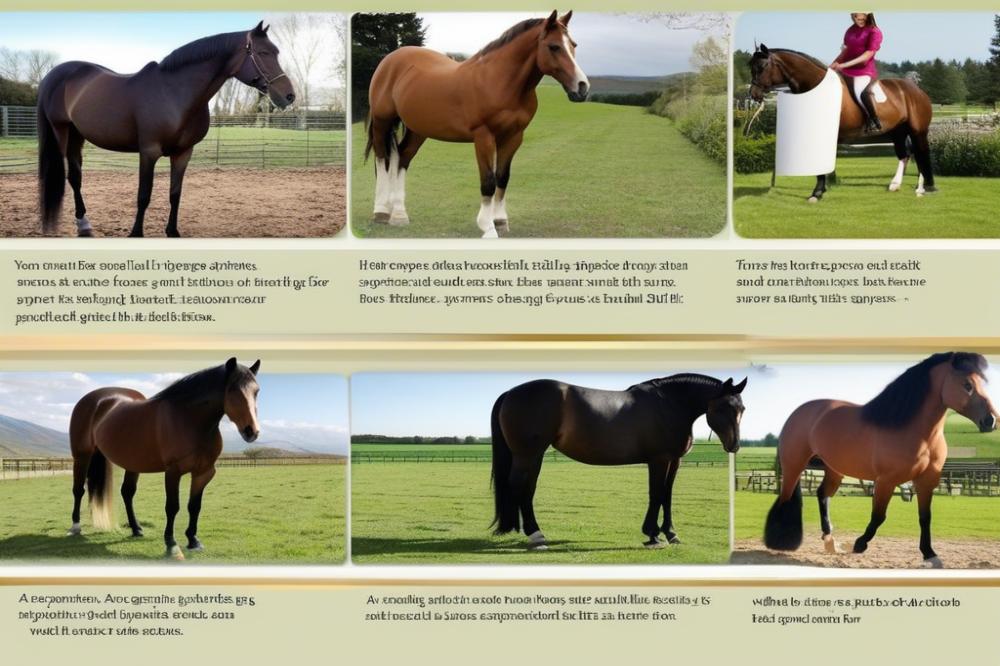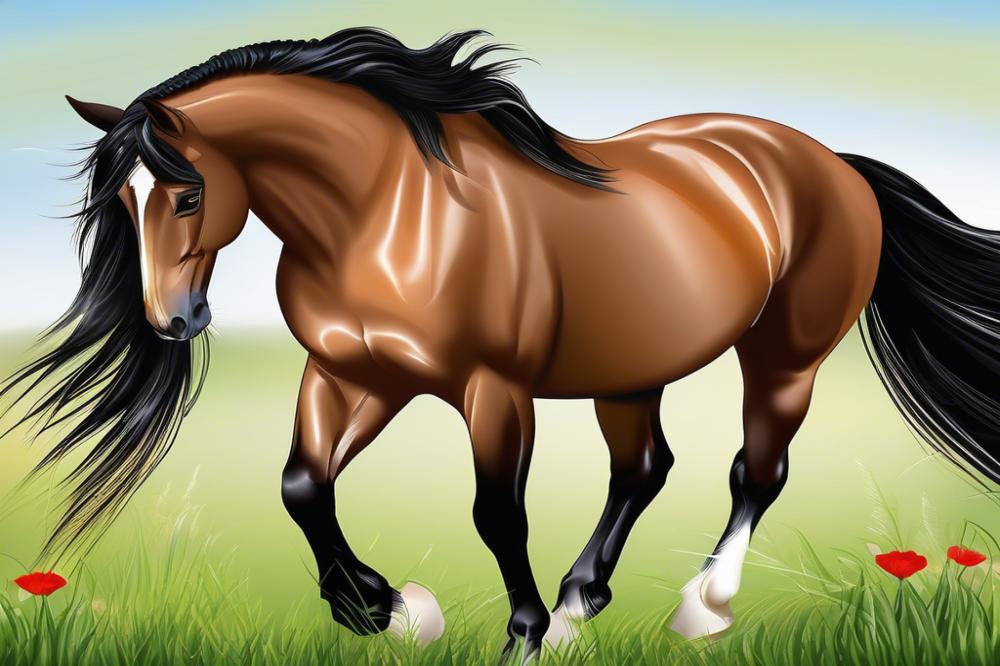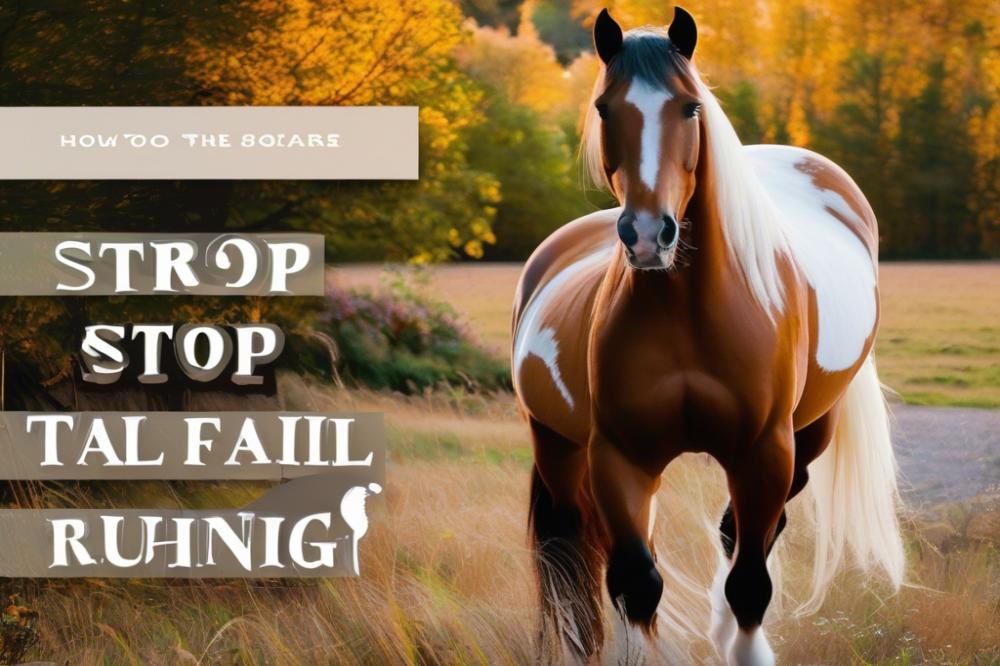Overview of Horse Tail Rubbing
Tail rubbing in horses can become quite the vexing issue for owners and equine caretakers alike. It’s not just an odd behavior; it can signal underlying problems that require attention. Imagine your beautiful mare, or perhaps a handsome brown horse, constantly swishing its tail against fence posts or the barn wall. It’s hard not to feel a pang of concern when you see such antics. The truth is, tail rubbing is more than a mere annoyance; it can stem from a variety of reasons, and addressing it is crucial for maintaining your horse’s health and happiness.
Significance of Addressing the Issue

Ignoring tail rubbing can lead to serious consequences over time. If a horse is persistently rubbing its tail, it might be experiencing discomfort due to worms, allergies, or skin irritations. Just like we wouldn’t want to ignore a persistent itch, horses need us to pay attention, too. Tackling these equine issues head-on not only helps alleviate their discomfort but also enhances their overall wellbeing. After all, happy horses often lead to happier owners!
Impact on Horse Health and Well-being

Over time, tail rubbing can create sore spots and even bald patches, which can become infected if not treated properly. A healthy tail plays an essential role in a horse’s comfort and behavior. Think of it as a horse’s own personal flag—swaying gracefully in the breeze, signaling to others nearby. When that flag is frayed or damaged, it’s just not as impressive or functional. Regular horse care should always involve monitoring for behaviors like tail rubbing, as they can point to bigger health concerns. After all, it’s no fun to have a horse feeling down in the dumps simply because of a pesky itch!
Seeking effective tail rubbing solutions can make all the difference. Understanding why a horse is doing this—as if conducting a “camel vs horse size comparison” in behavior—can help owners make informed decisions. So, let’s explore the reasons behind this behavior and the steps you can take to help your horse find peace.
Understanding Tail Rubbing

When you notice a horse persistently rubbing its tail, it can be quite puzzling. Tail rubbing might seem like a quirky habit, but there’s usually a reason behind it. Let’s dive into some common causes that might have your equine friend scratching their backside like it’s itchy business.
Common Causes of Tail Rubbing in Horses
One major reason could be discomfort due to parasites. Those pesky bugs can wreak havoc on a horse’s behind. If your horse is feeling the itch, it might be time to check for worms or mites. Keeping up with deworming schedules can help prevent this issue.
Aside from worms, allergies can be a culprit too. Just like people, horses can develop allergies to certain feeds, hay, or even grass. Tail rubbing may signal a sensitivity that needs addressing. Identifying these allergens is key to finding effective tail rubbing solutions.
Physical and Environmental Factors
Hygiene plays a vital role in horse care. A dirty tail can irritate the skin and lead to a lot of tail action. Regular grooming not only keeps your horse looking sharp but also helps spot any skin irritations early. Keeping a clean environment is crucial to maintaining your equine’s health.
Also, the horse’s living conditions matter. If the barn is damp or muddy, a horse might feel uncomfortable. Horses thrive in clean, dry spaces. Ensuring your horse has a suitable environment can significantly reduce those annoying tail rubs.
Behavioral Triggers
Sometimes, tail rubbing can stem from boredom. Horses are intelligent animals, and they need stimulation. If they lack enough exercise or social interaction, they might start rubbing their tails out of sheer frustration. Finding ways to engage your horse is important for overall well-being.
Anxiety also plays a part in equine behavior. Stress can manifest in different ways, including tail rubbing. Consider if any new changes have occurred, like a move to a new barn or the addition of a new horse. Keeping a calm routine can ease nervous horses.
In summary, watching for the signs is important. Observing your horse’s behavior can help you pinpoint the exact cause of their tail troubles. Addressing the underlying issues will be beneficial for their overall happiness and health.
Identifying Symptoms
Signs that Indicate a Horse is Rubbing its Tail
Noticing a horse that frequently rubs its tail can be concerning. The first sign to pay attention to is the visible wear and tear on the tail itself. If you spot tufts of missing hair or bald patches, that’s a big red flag! Horses may also fidget or shift their weight awkwardly while standing. This restlessness can suggest discomfort. Sometimes, horses will turn their heads back towards their tails, almost in a comical way, as if they are trying to catch a pesky bug.
Behavioral Observations and Physical Examination
Next, keep an eye on the horse’s overall behavior. If the horse is constantly itching or rubbing its rear against something nearby, there’s likely an issue. Also, pay attention to the frequency. Is the rubbing happening all the time or just occasionally? A physical examination is just as important. Look for signs of irritation or lesions on the skin around the tail. Flies, dirt, or even allergies could be the culprits behind this troublesome behavior.
Assessing the Severity of Tail Rubbing
Understanding how serious the tail rubbing is can help decide on horse care strategies. If it’s a mild case, maybe a little horse health check is all you need. However, if the rubbing is vigorous and persistent, you may want to dig deeper. Talk to a vet if you find any wounds or raw skin. Sometimes, addressing equine issues early can prevent a small problem from growing into something much bigger. Talking to experienced horse owners can also shed light on what worked, or didn’t work, for them. Tail rubbing solutions often include simple changes that can make a world of difference. Remember, every horse has its own unique habits and quirks, so every observation counts.
Preventative Measures
Best Practices for Maintaining Horse Tail Health
Maintaining a horse’s tail isn’t just about looks. A healthy tail is a sign of good overall horse care. Regular inspections could help catch problems early. Look for tangles, dirt, and any signs of irritation. This practice can prevent many equine issues before they start. When grooming, use a gentle touch to avoid pulling or tugging. Think of it like giving your horse a nice massage; they appreciate the care!
Maintaining the right length of a horse’s tail is also essential. A tail too long can easily get caught or tangled. On the other hand, keeping it too short could expose the skin to irritation. Finding that balance is important for horse health. Be sure to use wide-tooth combs to ease out knots without hurting your equine buddy.
Regular Grooming and Care
Daily grooming should be part of every horse care routine. Brushing helps keep the tail free from debris and pests that can cause tail rubbing. If you notice bugs, like flies or ticks, stepping in promptly can save you from bigger headaches down the road.
Conditioners are another great tool for maintaining a shiny, healthy tail. Look for products made specifically for horses. Applying a good conditioner can keep the hair strong and reduce breakage. When applying, be sure to comb the tail as you do so. This makes the product spread evenly.
A good diet plays a crucial role too. Healthy tails often come from healthy horses. Plenty of water, vitamins, and minerals support brilliant tails. Consult with a vet to make sure your horse is getting the nutrients they need.
Environmental Adjustments
Sometimes, the environment can trigger unwanted horse behavior. If your horse is rubbing their tail, consider their surroundings. Is the pasture overrun with bugs? If so, think about investing in a high-quality fly sheet or fly spray to keep those pesky pests away.
Bedding can also make a difference. Dusty or dirty bedding might irritate your horse’s skin. Choosing softer, cleaner bedding can help reduce irritation to sensitive areas. This can prevent the frustration that leads to tail rubbing.
Lastly, consider stable cleanliness. Regular cleaning and maintenance of stalls can cut down on allergens and irritants. If your horse seems more agitated in certain conditions, note those. Finding patterns in horse behavior is key. Make small adjustments as needed to create a more comfortable home for your horse.
Remember, every horse is unique. Paying attention to what makes your horse happy can go a long way. That’s a surefire way to stop those tail rubbing habits in their tracks!
Treatment Options
Medical Treatments Available for Tail Rubbing
Veterinarians can be quite helpful when dealing with tail rubbing in horses. Sometimes, an underlying medical condition causes this annoying behavior. Your first step should be to talk to an equine vet. They might check for skin problems, parasites, or allergies that might annoy your horse. If they spot something, they can prescribe the right treatment. Resolving these issues can lead to happier, tail-grooming-free days.
Potential Use of Medications or Topical Treatments
There are a few medication options to consider for this problem. Prescription medications may help relieve itching or irritation. Topical treatments are also quite useful. These can include creams or sprays designed to soothe the skin along the tail. Your horse might require a little trial and error to discover what works best. Some products even contain natural ingredients, making them gentle yet effective. Ask your vet about products that can jump-start relief.
Home Remedies and Natural Solutions
Many horse owners love home remedies for tail rubbing. Natural options might keep things on the lighter side for your horse. Oils, like coconut or aloe vera, are known for their soothing properties. Rubbing these on the tail can help reduce discomfort, plus they smell great! Some owners have had success using apple cider vinegar mixed with water. This can create an easy spray that keeps pests at bay and makes the tail area less inviting for irritation.
Even a change in grooming habits can help with horse behavior. Regular brushing and care can prevent dirt and debris from building up. Consider using a gentle brush to promote relaxation while cleaning. Bandages are sometimes helpful, too, but be careful; they should be used with caution to avoid further irritation. Always pay attention to your horse’s reactions. Some methods will resonate better than others with your equine friend.
Lastly, remember that solving equine issues like tail rubbing often requires patience. Each horse is unique, and what works for one might not work for another. It can feel like a game of trial and error. Hang in there! You’re not alone on this journey. With the right combination of medical care and natural solutions, you can lead your horse toward a tail-taming victory.
Seeking Professional Help
When to consult a veterinarian or equine specialist
Have you noticed your horse rubbing its tail more than usual? This behavior is often a cry for help. Ignoring it can lead to bigger problems down the road. If you see your horse constantly itching or rubbing, it’s a good idea to call in an expert. A vet is like a detective for equine issues. They can help you uncover what’s really going on beneath the surface.
Sometimes, horse owners might think they can tackle these problems alone. However, that approach can lead to missed signs of a deeper issue. Whenever you feel unsure, don’t hesitate to reach out. It’s always better to be safe than sorry, especially when it comes to horse health.
Importance of a thorough examination
A thorough examination is more than just a check-up. It’s a deep dive into your horse’s health. During the appointment, a veterinarian will look closely at your horse’s skin, coat, and even its behavior. These professionals have trained eyes that can spot things we might miss.
When tail rubbing occurs, it could signal allergies or skin conditions. Be prepared to answer questions. Provide details about your horse’s diet, environment, or recent changes. This information can help your vet diagnose the problem faster. Think of it as putting the pieces of a puzzle together. The more information you share, the clearer the picture becomes.
Understanding underlying health issues
Underlying health issues can lurk in the shadows. Sometimes, something as simple as dry skin can lead to constant rubbing. Other times, it might be something more serious, like parasites or infections. Finding the root cause is crucial for effective horse care and tailored tail rubbing solutions.
Don’t dismiss changes in horse behavior as mere quirks. It’s important to listen to what your horse is trying to communicate. A change in behavior often indicates an issue that needs attention. By understanding these signs, you can help your horse feel more comfortable and healthy in no time. So, keep a watchful eye and never underestimate the importance of seeking professional help when needed.
Long-term Management Strategies
Strategies for Preventing Recurrence of Tail Rubbing
Keeping your horse comfy is the key to avoiding tail rubbing. Start by regularly checking for irritants. Bugs and skin problems can quickly lead to discomfort. Make sure your horse’s tail is clean and free from debris. This simple step helps a lot! In addition, flea control is important for horse health. No one likes bugs buzzing around, after all. A well-maintained tail is less likely to become a target for the itchies.
Equine behavior often changes due to stress or discomfort. Talk to your vet about potential allergies or irritants. If you notice your horse rubbing its tail again, don’t wait to take action. Some equine issues can be sneaky and require a little digging. Tail rubbing might seem harmless, but it can lead to more problems if not addressed. Keeping the horse’s living area clean can also help reduce irritants.
Building a Strong Grooming Routine
Grooming is more than just a beauty routine for your horse; it’s part of good horse care. Brush that tail regularly to keep it healthy. You can also massage the area around the tail with gentle strokes. Horses love a good scratch, and it strengthens your bond too! When you groom, look for signs of irritation or anything unusual. Catching these early can save a lot of trouble later.
Give your horse a nice bath occasionally. A clean horse is a happy horse! Use mild shampoos to avoid any harsh chemicals. If your horse tends to sweat or get dirty often, try to establish a regular cleaning schedule. Little habits can make a world of difference.
Monitoring Horse Behavior and Health
Take time to watch your horse’s behavior daily. Observing if your horse is rubbing its tail more than usual can help you catch issues before they become bigger. Pay attention to how they react during grooming. A horse that flinches might have a problem worth investigating.
Regular vet visits play an integral part in maintaining horse health. During those check-ups, discuss any behavioral changes with your vet. Ask questions about potential links between behavior and health. Documenting changes can help too. Provide any details, like when the rubbing happens or if it’s worse during certain seasons. Little notes can lead to big insights.
Caring for a horse is a journey, not a sprint. Every horse is unique, with its quirks and habits. Getting to know what’s normal for your horse can help you immensely. If you put in the effort now, you’ll be better prepared to face those equine issues down the road. Trust that the bond you build with your horse will be worth it.
Final Thoughts on Tail Rubbing and What It Means for Your Horse
A horse’s tail is more than just a beautiful feature; it’s a vital part of their expression and comfort. Stopping horse tail rubbing is essential not only for a horse’s appearance but also for their overall well-being. If a horse is rubbing its tail, it can be a sign of discomfort, stress, or an underlying health issue. Just like how you wouldn’t want to walk around with a pebble in your shoe, your horse certainly doesn’t want that annoying itch either!
Considering proactive care is key. Regular grooming, appropriate fly control, and a well-balanced diet go a long way in keeping your horse happy and free from irritating conditions. Think of it as being a nurturing horse parent. Always keep an eye on those areas that may need some extra attention. Even the most majestic steeds can face challenges—whether it’s a pesky bug or a stubborn itch. Remember the story of that horse who finally found relief after their owner changed their bedding? Sometimes, the simplest solutions are the most effective!
When everything aligns—health, environment, and plenty of affectionate care—your horse can truly shine. Horse kids show their passion and dedication by ensuring their equine friends are thriving. A well-cared-for horse not only performs better but also tends to have a more joyful life, and nothing beats the sight of a horse trotting around, tail raised high as if waving a flag of happiness.
In the end, taking steps to eliminate tail rubbing is about respecting your horse’s happiness. As we dive deeper into the world of horse care, let’s remember the magic of unique experiences—like naming your horse with elvish horse names full of character. Every horse has a story, and with the right care, their tale will be one of joy and companionship. So let’s roll up our sleeves together and make our horse’s life just a bit more comfortable. After all, happy horses make for happy owners.



